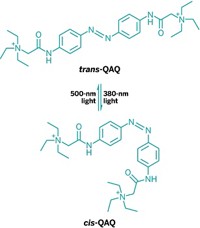Advertisement
Grab your lab coat. Let's get started
Welcome!
Welcome!
Create an account below to get 6 C&EN articles per month, receive newsletters and more - all free.
It seems this is your first time logging in online. Please enter the following information to continue.
As an ACS member you automatically get access to this site. All we need is few more details to create your reading experience.
Not you? Sign in with a different account.
Not you? Sign in with a different account.
ERROR 1
ERROR 1
ERROR 2
ERROR 2
ERROR 2
ERROR 2
ERROR 2
Password and Confirm password must match.
If you have an ACS member number, please enter it here so we can link this account to your membership. (optional)
ERROR 2
ACS values your privacy. By submitting your information, you are gaining access to C&EN and subscribing to our weekly newsletter. We use the information you provide to make your reading experience better, and we will never sell your data to third party members.
Materials
Mechanical Maneuvers Enable Fruit Fly Sight
Membrane contraction is key to translating light into electrical signals
by Jyllian Kemsley
October 15, 2012
| A version of this story appeared in
Volume 90, Issue 42
The missing link in understanding the conversion of light to an electrical signal in Drosophila photoreceptor cells might be a mechanical contraction of cell membranes (Science, DOI: 10.1126/science.1222376). The complex path of sight starts with photoisomerization of rhodopsin (a G-protein-coupled receptor; see page 6), goes through cleavage of the inositol head from the membrane phospholipid phosphatidylinositol 4,5-bisphosphate (PIP2), and ends with opening of an ion channel to import Ca2+ and Na+ into the cell. But how, exactly, hydrolysis of the phospholipid triggers opening of the ion channel was a mystery. Roger C. Hardie and Kristian Franze of Cambridge University noticed that light flashes induced physical contractions in photoreceptors, which they measured using atomic force microscopy. Cleaving the bulky inositol head from PIP2 releases a proton and leaves behind a slimmer diacylglycerol in the membrane lipid bilayer, allowing receptor membranes to contract. The mechanical force of the contraction, combined with the released proton, triggers opening of the ion channels, the researchers propose. “The study of Hardie and Franze highlights the emerging concept that transmembrane proteins are sensitive to the membrane environment,” says University of Southern California neurobiologist Emily R. Liman in commentary about the work.




Join the conversation
Contact the reporter
Submit a Letter to the Editor for publication
Engage with us on Twitter